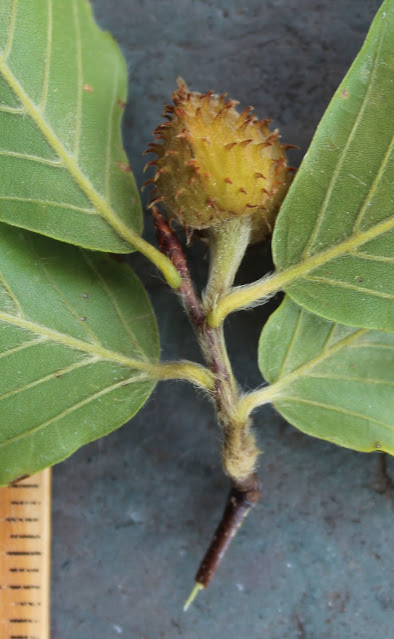 |
| The American beech grows next to the intersection of two gravel paths, necessitating the removal of its lower branches. |
 |
| From another angle, we see that the straight trunk appears to lean slightly to the left. |
 |
| On the gravel path beneath the American beech, we see its fruits and husks, mixed in with some pine straw of course. |
 |
| Looking upward from the ground, we see a single fruit. Since the lower limbs have been removed, without the aid of a ladder, we cannot closely examine the fruits that are still attached to the tree. |
 |
| However, there are plenty of leaves to study at ground level. |
 |
| It appears that the American beech suffered during the August heat wave: leaf edges are crispy. |
 |
| With a ladder, we can see a whole lot more! The interesting fruiting structure, called a cupule, is cracked open. |
 |
| Twigs were snipped for measurement and comparative photos. This twig does not have any fruit. |
 |
| We see simple, alternating leaves with serrate margins and short petioles, as well as sharply pointed dark brown leaf buds. |
 |
| Turning the leaves over, we can better appreciate the highly textured leaf surface resulting from the pronounced venation. |
 |
| Also, zooming in on the twig, we see white fuzzy stuff on the leaves and twig. A twig with fruits looks a little different.... |
 |
| This twig was snipped with the aid of a ladder. Several cupules are attached. All are open and intact. |
 |
| This cupule hasn't dried out completely. Although not visible from this angle, the cupule has opened slightly. |
 |
| Zooming in on the twig, we see that it is significantly fuzzier than the non-fruiting twig, and there is a pointed leaf bud tucked in beside the cupule. |
 |
| The cupules measure between a ½ inch and ¾ inch in length, and they are uniformly covered in curved spikes. |
 |
| The cupules are fuzzy. The little spikes look threatening, but they are harmless. Compare this with the vicious hybrid chestnut in the arboretum collection (see Dunstan here). |
 |
| This cupule had to be pulled apart to reveal the fruits of the American beech, two edible nuts, which are still green. Each nut has three flat sides. Don't eat too many. |


